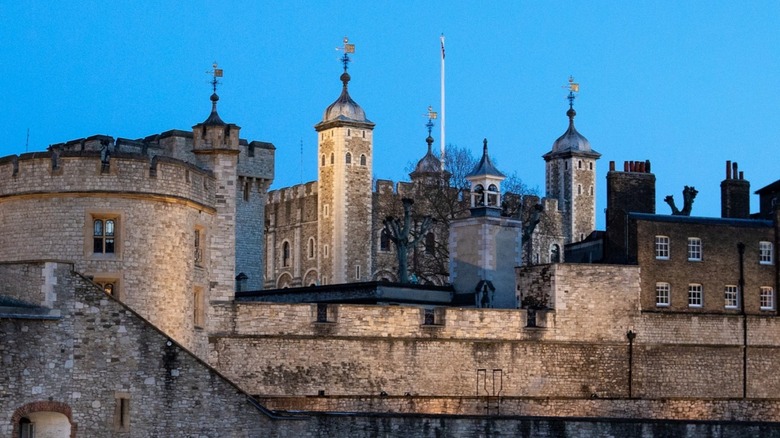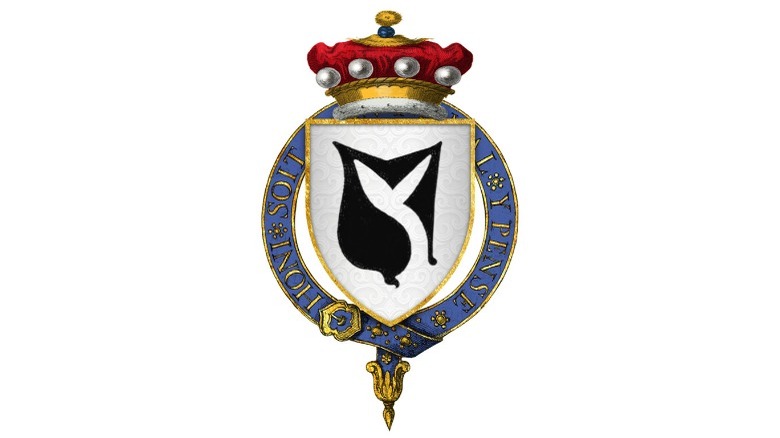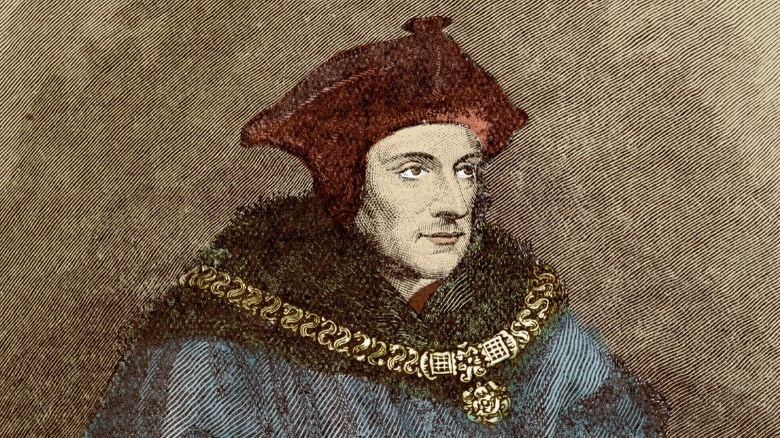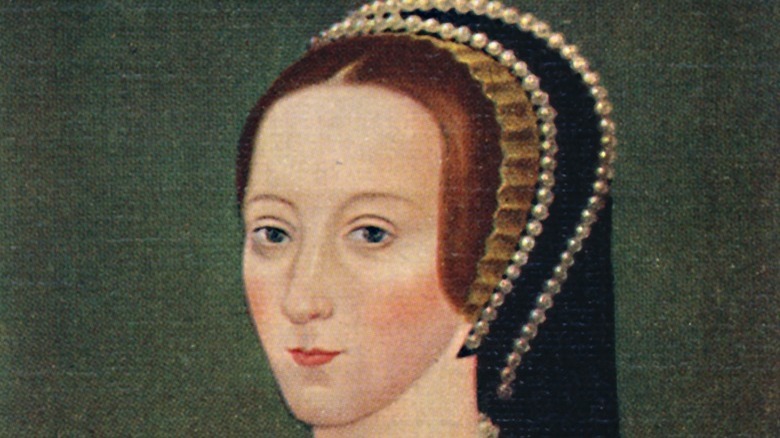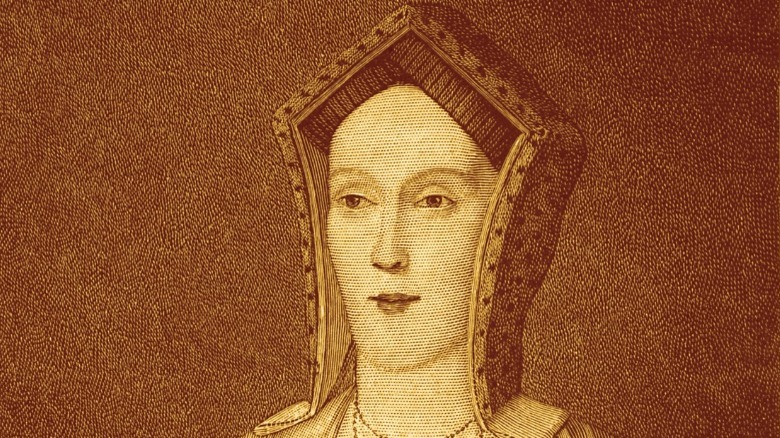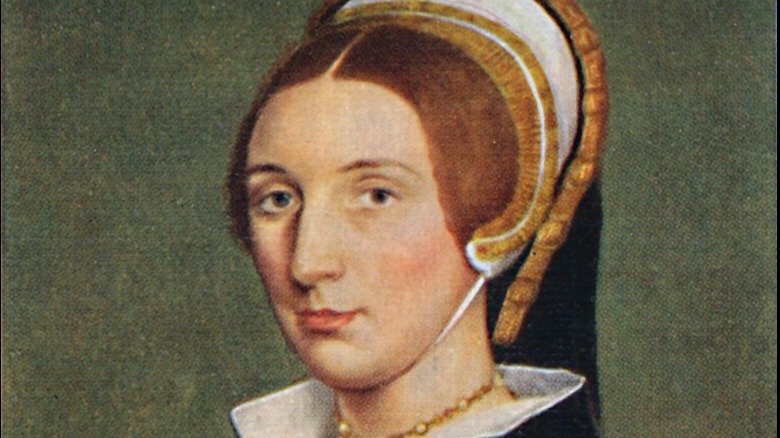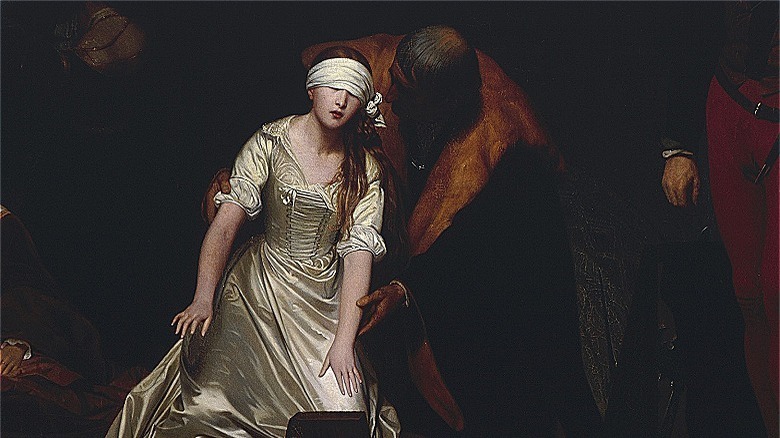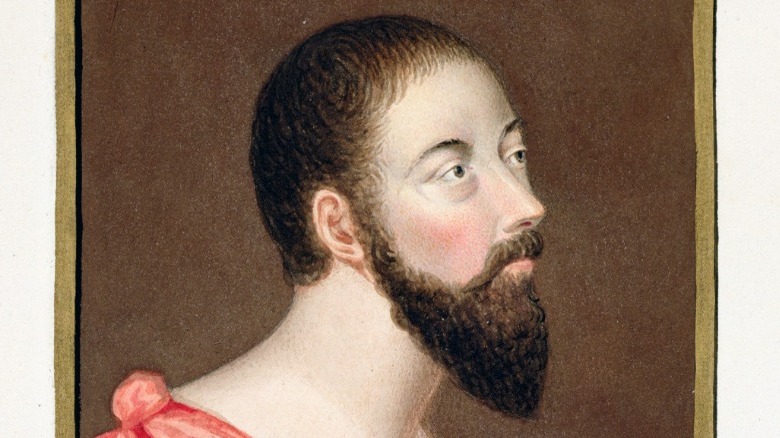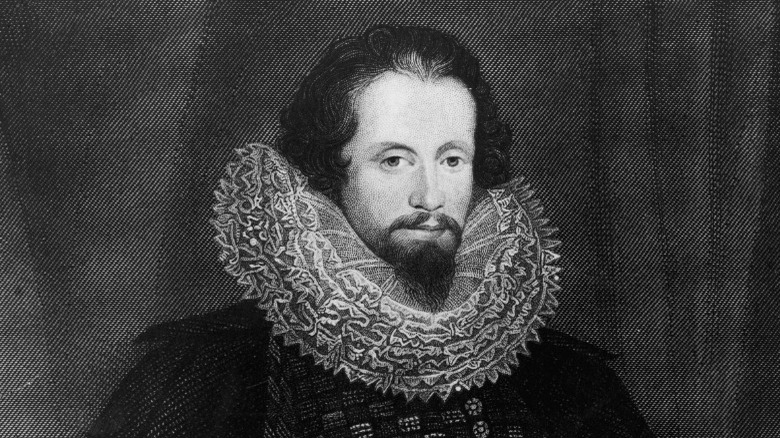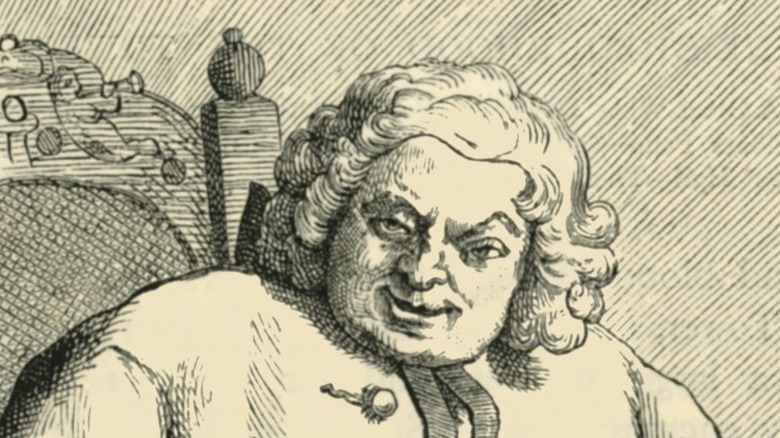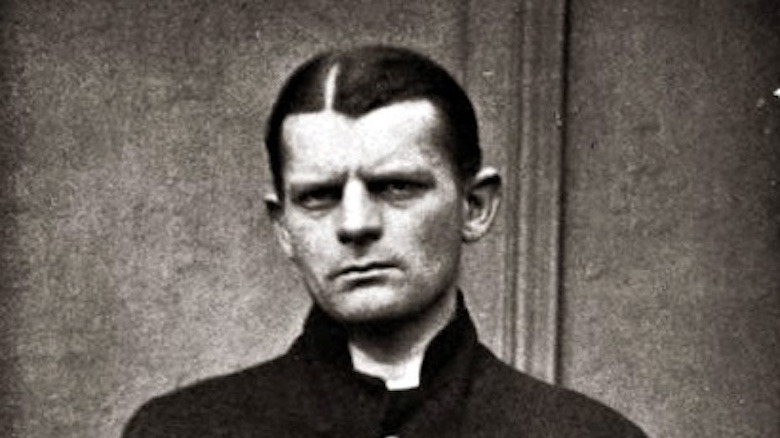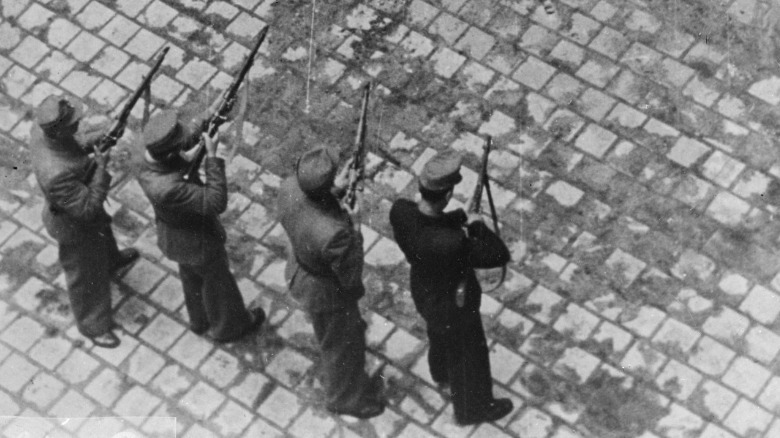The Most Notable Deaths In The Tower Of London
Situated on the bank of the River Thames and just outside the Square Mile, the Tower of London was built by the Normans in 1070s (via Historic Royal Palaces). Led by William the Conqueror, the Normans were Viking settlers in northern France. They invaded England through 1066 and won a decisive victory at the Battle of Hastings on September 28, 1066. On Christmas Day, William the Conqueror was crowned the king of England at Westminster Abbey (via History). In the centuries after, the Tower of London became known for torture and execution, especially in the 16th and 17th centuries, according to Historic UK.
The Tower of London complex consists of the White Tower, Tower Green, and various other buildings and accommodation, but only a minority of the executions occurred there. The vast majority occurred at the nearby Tower Hill, just a short walk from the complex.
Here are the most notable deaths in the Tower of London.
William Hastings
The execution of Lord William Hastings in 1483 is a chilling example of how medieval justice was delivered summarily and without mercy. A figure in the Wars of the Roses, which raged from 1455 to 1485, historian John Goodall described Lord Hastings as a "hugely powerful figure" who had more sway over King Edward IV "than any man alive." In fact, Hastings had such a way with people that he managed to be "almost universally liked and respected" by both allies and rivals.
This all changed on June 13, 1483, days after King Edward IV's death. Lord Hastings was called to attend a council meeting in the Tower of London hosted by Richard, Duke of Gloucester, one of Hastings' many allies. Instead of routine discussion, Gloucester, who was consumed by power and his proximity to the throne, accused Hastings of conspiracy and had him dragged onto Tower Green, where he was beheaded with an axe (via The Untold Path).
Just two weeks later, Richard, Duke of Gloucester, would despose Edward V, the 12-year-old successor, and be crowned Richard III, reigning for just two years until his death at the Battle of Bosworth in 1485 (via Britannica).
Sir Thomas More
Sir Thomas More held various positions in the 1520s, such as chancellor of England, speaker of the House of Commons, and secretary, confidant, and "intellectual courtier" to King Henry VIII (via Biography). More was also a writer, publishing his book "Utopia" in December 1516, according to Britannica.
More's religious views were staunchly Catholic, which became at odds with Henry when the king split with the Roman church in 1534 (via Royal Museums Greenwich). The split was enacted by the Act of Supremacy, which declared Henry as the Supreme Head of the Church of England, allowing the tyrant to divorce at will. According to All That's Interesting, the law demanded that all subjects accept this by taking the Oath of Supremacy, which More could not abide by.
When More refused to accept the oath, Henry imprisoned him for treason on April 17, 1534. More could have taken the oath and received a pardon, but the Renaissance man stuck to his principles. Before his beheading on Tower Hill on July 6, 1535, More said, "I die the King's good servant, and God's first."
Anne Boleyn
Obssessed with having a male heir, Henry VIII had Thomas Cranmer, the first Archbishop of Canterbury, annull his marriage to Catherine of Aragon on May 23, 1533 (via Britannica). Shortly before that, on January 25, Henry had secretly married Anne Boleyn (via Britannica), who was over 20 years younger than Catherine. She quickly fell pregnant, although the child would be another daughter, the future Elizabeth I.
After a miscarriage and stillborn son, Henry is said to have lost interest in his second wife and had trysts with other women. On May 2, 1536, Henry charged Boleyn with adultery and incest, committing her to the Tower of London. Boleyn was viewed as arrogant by the court, who found her guilty of the dubious, capital offences.
Boleyn was killed 17 days after her detainment on May 19, 1536. According to Capital Punishment UK, Boleyn was taken to Tower Green and beheaded with a sword. She was around 30 years of age at the time of her death.
Henry Courtenay, 1st Marquess of Exeter
Son of Katherine of York, Henry VIII's aunt, Henry Courtenay was a supporter of Henry VII and served in the English navy during the French Wars of 1512-13 (via Tudor Times). Henry rewarded Courtenary for his loyalty, appointing him to the Privy Council in 1520 and bestowing roles and titles such as Knight of the Garter in 1521 and Marquis of Exeter in 1525.
However, despite this relationship, Courtenay would fall foul of Tudor England's brutal politics. After a falling out with Thomas Cromwell, one of Henry's closest servants (via Historic Royal Palaces), the king sent Courtenay to suppress the Pilgrimage of Grace with Charles Brandon, Duke of Suffolk.
Courtenay failed to redeem himself during the Pilgrimage of Grace, called one of the greatest uprisings of the Tudor period by Tudor Times. On November 5, 1538, Courtenay was arrested on grounds of conspiracy. After a trial, Courtenay was found guilty on December 9, 1538, and beheaded on Tower Hill.
Margaret Pole, Countess of Salisbury
An enemy of Henry VIII, Margaret Pole's death was a botched, horrific affair. Born into the royal Plantagenet family, Pole enjoyed great wealth at the beginning of Henry's reign owing to her title, the Countess of Salisbury, which came with substantial income from land and estates (via Tudor Society).
However, her intense Catholic faith, which she shared with her son Reginald, would put her in a very dangerous situation during Henry's secession from the Pope and the Catholic church. When Reginald expressed his stern disapproval of Henry's Act of Supremacy, the king oppressed every family member he could. In 1539, Pole was stripped of her land and title and sent to the tower, where she was sentenced to death aged 65, which was elderly for the period.
On May 27, 1541, Pole was told that she be dead within an hour. According to a distubring account in the Calendar of State Papers, Pole was executed by a "blundering youth" who "hacked her head and shoulders to pieces," causing the Imperial Ambassador Chapuys to write, "There was no need or haste to bring so ignominious a death upon her."
Catherine Howard
According to The History Press, Catherine Howard met an older, plumper Henry VIII as he entered the final years of his life. Yet Howard knew how to get a man's attention, and she successfully enticed the increasingly corpulent, miserable king, whom she would marry just three weeks after his annulled marriage to Anne of Cleves (via History Extra).
Howard had discovered her sexuality with Henry Manox, her music teacher, and especially Francis Dereham, a young man who was not only handsome but fun and affluent. Both Howard and Dereham would admit to consummating their relationship, which would fuel deadly rumors shortly after her marriage to Henry. Six months into her marriage to Henry, Howard is said to have exchanged gifts with Thomas Culpeper, with whom she also met privately. Rumors began to spread that eventually reached Henry, who demanded that an investigation be launched.
Any illusions of virginity were shattered when both Manox and Dereham admitted to their intimacies with Howard, who prostrated herself before Henry: "I was so desirous to be taken unto your Grace's favour and so blinded with the desire of worldly glory that I could not, nor had grace, to consider how great a fault it was to conceal my former faults from your Majesty." Her pleas were unsuccessful. On February 13, 1542, Howard was beheaded on Tower Green (via Capital Punishment UK). According to Historic Royal Palaces, Howard could have as young as 17.
Lady Jane Grey
Known as the "Nine Days' Queen," Lady Jane Grey was beheaded on February 12, 1554. As her moniker suggests, Grey's curious reign started just nine days prior, following the death of her cousin King Edward VI, who chose Grey to be queen because she was a protestant (via Historic UK).
Like so many times before, faith would be a driving force of her death. According the History, the Royal Council's support for Grey's reign was challenged by Mary I, the Catholic daughter of Henry VIII with an army of supporters who considered her the rightful heir to the English throne. To combat this force, Grey's husband Lord Guildford Dudley assembled a force of his own. However, the Royal Council reneged on their support for Grey, declaring Guildford a traitor and naming Mary as the queen.
By July 20, support for Lady Jane Grey had all but evaporated. She was detained at the Tower of London, where she and her husband were charged with treason. Both were found guilty and setenced to death, but Mary I would not sign their death warrants until the Wyatt Rebellion, which shocked Mary into killing all political adversaries. According to Capital Punishment UK, Lady Jane Grey was the last person to be executed on Tower Green, which was reserved for private executions of high-status individuals (via Historic Royal Palaces).
Sir Thomas Wyatt
According to Capital Punishment UK, most people executed at the Tower of London were beheaded. However, this method was deemed insufficient for some offenders. Thomas Wyatt was one such offender, so his body was quartered after an executioner had removed his head.
Thomas Wyatt was the leader of the Wyatt Rebellion, which was a plot to dethrone Catholic Mary I and replace her with her half-sister Elizabeth, a Protestant (via Tudor Society). However, the plan failed to materialize owing to a "lack of organization." In February 1554, Wyatt marched on Ludgate with a small force, but he was outnumbered and outmanoeuvred by Mary's soldiers, who forced Wyatt and his men to surrender.
Wyatt was tried at Westminster Hall on 15 March and he protested his innocence, but a death sentence was all but inevitable. Just under a month later, on April 11, Wyatt was taken to the scaffold at Tower Hill, where he was beheaded and butchered. In grisly Tudor fashion, his quartered remains were parboiled and nailed up in Newgate, while his head was displayed at St James', where it would disappear, presumably stolen.
Robert Devereux, 2nd Earl of Essex
According to History Today, Robert Devereux was a chilvarous aristocrat known for his charm and energy and popular with Queen Elizabeth I, with whom Devereux danced and played cards, despite their 33 age gap. However, Devereux was also jealous, thin-skinned, and irritated by female authority. For example, he once turned his back to Elizabeth in frustration, which was a grave violation of etiquette. Outraged, the queen hit Devereux on the side of the head, causing him to get even angrier. For forgiveness, Devereux was sent to repress an Irish uprising in 1599, yet he failed in his objective and blamed everyone but himself.
Upon his return to England, Devereux was suspended from his duties and placed under house arrest. No doubt apoplectic, Devereux assembled a mob of a hundred men on February 8, 1601. He led this baying crowd towards the City of London, encouraging passers-by to join him in his mission. Only a fool would have obliged.
On February 19, Devereux was found guilty of treason and sentenced to death. As he was escorted to Tower Green, the vainglorious nobleman said that he was "thus justly spewed out of this realm." Disturbingly, it would take three strikes of an axe to finish the job. He was only 33 years old (via Britannica).
Simon Fraser, 11th Lord Lovat
Known for bravado and violence, Simon Fraser was the last man to be beheaded in all of England on April 9, 1747 (via Britannica). According to the Crown Chronicles, Fraser was killed on suspicion of being a Jacobite and for supporting Charles Edward Stuart, known as "Bonnie Prince Charlie."
Fraser's actions were part of the Jacobite rising, which was a Scottish effort to "restore the House of Stuart to the British throne," according to the National Army Museum. Bonnie Prince Charlie assembled fighting forces to attack inexperienced English troops, defeating a group led by Sir John Cope at the Battle of Prestonpans on September 21, 1745. The Jacobites continued southwards, but exhaustion caused Bonnie Prince Charlie to retreat. The Jacobite cause would come a head at the Battle of Culloden on April 16, 1746. According to The Scotsman, Simon Fraser rallied his own fighting clan, but his men were butchered on Culloden Moor, causing him to flee to the Highlands.
Fraser was caught on Loch Morar and taken to London, where he was found guilty of treason. Moments before his execution on Tower Hill on April 9, 1747, Fraser remarked, "Dulce et decorum est pro patria mori", a Latin expression meaning "It is sweet and seemly to die for one's country".
WW1 spies
From 1914 to 1916, 10 German spies were executed by firing squad at the Tower of London (via Capital Punishment UK). According to Historic Royal Palaces, the first of these spies was Carl Hans Lody, a German naval officer who arrived in Britain at the beginning of the First World War.
Posing as an American, Lody travelled to Scotland, where he had orders to spy on Britain's naval capacity. However, Lody thought he was "not a fit man for that kind of job" and was quickly identified by MI5. Lody was held at the Wellington Barracks, where he was found guilty of espionage and sentenced to death. He was executed by firing squad at the Tower of London's firing range on November 6, 1914.
According to the BBC, Lody was the first man in over 150 years to be executed at the tower. His death was followed by the executions of fellow spies Karl Friedrich Muller, Haike Marinus Petrus Jansson, Wilhelm J. Roos, Ernst Waldemar Melin, Fernando Buschman, George Traugott Breekow, Irvin Guy Ries, Albert Meyer, and Ludovico Zendery Hurwitz.
Josef Jakobs
Josef Jakobs was a spy who worked for the Abwehr, Germany's military intelligence unit. Trained in wireless communication, Jakobs was transported to England in the hold of a German bomber on January 31, 1941. However, Jakobs injured his ankle when he left the aircraft's hatch and only worsened his injury when he parachuted into a farm in Huntingdon (via Story of Josef Jakobs).
It was some time after 8:30pm and Jakobs was in extreme pain, so he resorted to chainsmoking throughout the night. The next morning, Jakobs was found by two farm hands who handed him over to local police; they diagnosed a broken ankle but sent the German spy to London, where he stayed in Brixton prison.
After several months of fever, sepsis, and interrogations, Jakobs was charged with violating the Treachery Act of 1940 on July 24, 1941. Soon after, on August 5, Jakobs was found guilty and sentenced to death. 10 days later, he was taken to the same miniature firing range used during the First World War. He was strapped to a chair, cloaked with a hood and presented with a circular target on his chest. According to the coroner, Jakobs died "due to the passage of bullets through the heart." Per Capital Punishment UK, he is the last person to be executed at the Tower of London.
